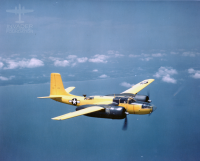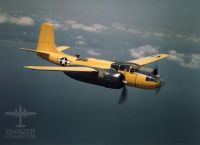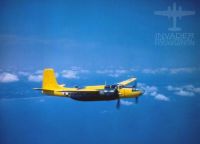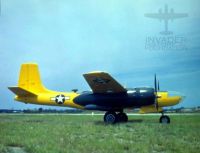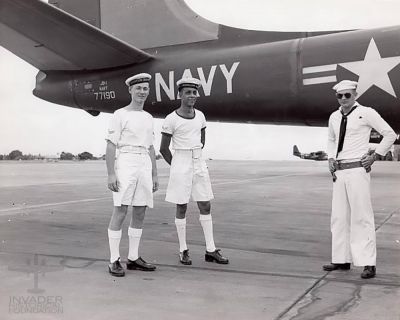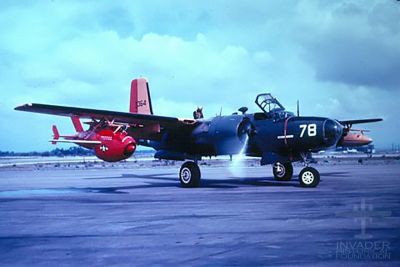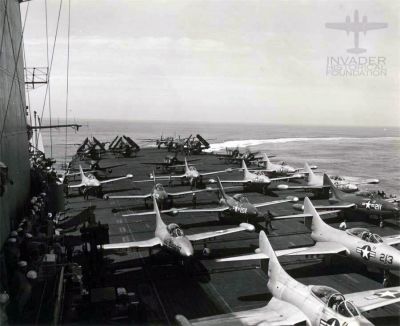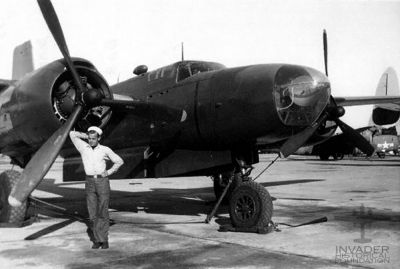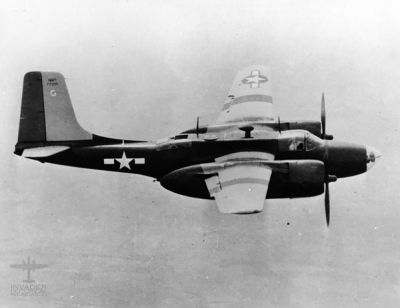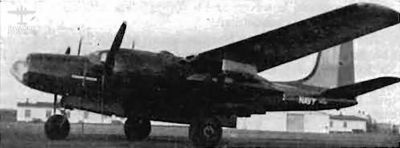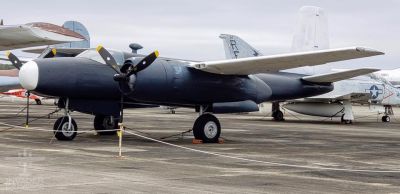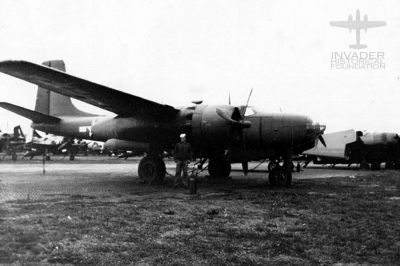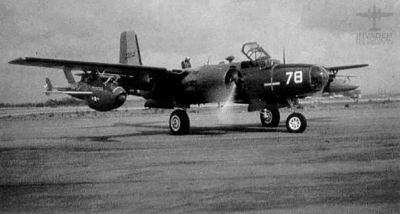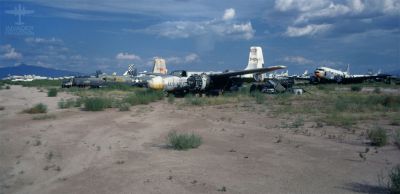United States (Navy)
The US Navy was the 3rd most prolific operator of the Douglas Invader, after the US Air force, and the French Air Force (Armeé de L'Air). The Navy operated 152 Invaders under the designation JD-1 - or "Jim Dogs", as the sailors called them. The JD-1s were used as utility planes that towed aerial targets and many were modified to be drone carriers and became JD-1D.
In 1962 the Navy combined designation systems with the Air Force. The JD-1 became the UB-26J, and the JD-1D became the DB-26J.
Accuracy of Information
There is a not a lot of information about the JD-1s readily available online, which may be why much of what is published is wrong.
Some sources only list JD-1s as being active in VU-3, 4, 7, and 10. However, photographic evidence proves the JD-1s were active to some extent in almost all of the Utility Squadrons, as well as several others.
Similarly, some sources claim that only 141 Invaders were given to the Navy, but we have BuNos for 152 of them.
Some sources claim that only 1 XJD-1 was developed, but we have information of two different XJD-1s.
Due to lack of easily accessible records, our information is also currently incomplete. However, despite this limitation, this should be the most accurate information on the JD-1s anywhere, as we are actively working with the Naval Aviation Library to fill in some archival gaps and then comparing the US Navy data with the USAF data and primary and secondary sources to create a clearer picture of the Navy’s planes. As always, we will correct any mistakes and continually update our information as new records become available. Note that some of the plane's individual records have been lost to time so there will be some occasional gaps, but these will be explicitly noted and called out as they are discovered.
I would also like to personally thank the volunteers at the US Naval Aviation Museum Library for assisting me by sending me archival records and humoring my many requests. I would not be able to compile this data without their help. In particular, Pam Thomas, Bob Thomas, Bonnie Towne, and Bill Addison - thank you.
Background and Development
As WWII was winding down the US Navy wanted some aircraft for target tugs and general utility use. The US Army Air Corps happened to have roughly 200 Invaders laying around that they didn't want. These planes had been custom built for the British Royal Air Force, but the RAF cancelled the order as the war was winding down in Europe and the bombers were superfluous at that point. Being modified to RAF specifications, the USAAC didn't want them.
Two prototypes were developed for the Navy. Ex-USAF 44-34217 became a hard nose XJD-1 Prototype, and 44-35467 became a glass-nosed XJD-1 Prototype. Both of the XJD-1 Prototypes were tested at NAS Norfolk and assigned to Utility Squadron 4 [1]. At this time the squadron was designated VJ-4, but later it would be designated VU-4. The XJD-1s were painted gloss yellow all overall with gloss black engine nacelles. Of the two, the Navy preferred the glass-nosed version, and placed an order to procure 150 more, the vast majority of these coming from the unused RAF Invaders.
Initially, the Navy's JD-1 planes kept the standard C-Model nose. The standard equipment on the JD-1 was the Pratt & Whitney R-2800-27 2,000 horespower engine. [2][3]

Eventually this transitioned to a version that painted over the upper portion of the nose was painted in line with the fuselage panel. The result was that only the very tip of the nose was left exposed. The Navy mounted aerial radar into the noses of the JD-1s.
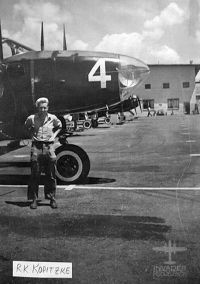
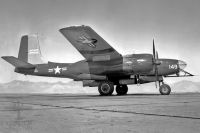

Eventually, the standard C-model noses were replaced with custom noses built specifically for the JD-1 and the radar dish.


It's important to note that while all of the Navy Invaders eventually converted to the new nose design, not all of the planes were equipped with the nose radar. There are numerous pictures of planes with no nose radar equipment at all.
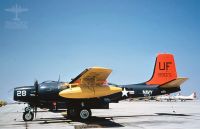

The Navy Invaders had a mix of the Generation 2 (flip up) and Generation 3 (clam shell) canopy designs.


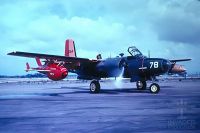



As early as 1952 the US Navy had their standard JD-1 target tug planes, and some JD-1D drone controller planes which operated the Ryan Firebee drones [4]. The records also show that they had experimental versions of both, which were designated the JD-1X and JD-1DX, respectively [4]. At this time I do not know what makes these experimental versions different from the standard versions.
Throughout it's more than 20 year service history with the US Navy, The Invader went through several paint scheme changes. The summary of those changes and their colors are listed below.
1944
SR-2e - Dated 26 Jun 1944 - Effective 7 Oct 1944:
Target towing and primary trainers are to be painted Orange Yellow.
1946
SR-15e, Amendment 4 - Effective 6 May 1946:
After the end of the war the emphasis was placed on safety rather than on concealment. To this end instructions were issued for the high visibility painting of target towing aircraft.
Multi-engine aircraft regularly assigned this mission were to have the top and bottom of all airfoil sections of the Wings, vertical fin, horizontal stabilizer, and elevators painted glossy Orange Yellow. The fuselage, engine nacelles and cowlings, except those portions included within topside of the wing platform, were to be glossy Sea Blue. Wing walkways on both sides of the fuselage, extending 18 inches (45.72 cm) outboard, on the topside of the wings only, were 10 be painted glossy Sea Blue. These walkways could be eliminated from aircraft where the crew did not walk on the wing to enter the aircraft. When applied, they extended from extreme leading edge to trailing edge of the wing. The rudder(s) and three foot (91.44 cm) wide bands around the wing were to be glossy Insignia Red. These bands were to be parallel to the thrust line and midway between the national aircraft insignia and outboard nacelle. In the event of insufficient space for the red wing band between the insignia and nacelle, the band was to be located adjacent to the nacelle. The national aircraft insignia could overlap the band. but the band could not cover or alter the insignia size or location.
1955
SR-202 was superseded by the new Military Specification MIL-C-18263(Aer), dated February 23, 1955.
Target Towing and Drone Control aircraft were given a new paint scheme reflecting the general change from the Sea Blue of the past ten years. The fuselage, cowling and engine nacelles on multi-engine aircraft were Engine Gray except surfaces extending into the topside of wings. In this case, these surfaces were painted to match the wings. The wings, horizontal stabilizer, elevators and vertical fin were Orange Yellow. The vertical fin fairing was painted to match the fuselage. The Orange Yellow terminated on a line formed by projecting the fin leading edge down to the fuselage. Wing walkways could be either Engine Gray or, in the case where the wing is utilized to enter the aircraft, they could be antiskid black material. The rudder was painted Insignia Red. Insignia Red bands 3 feet (91.44 cm) wide encircled the wing panels.
Target drones were to be overall Insignia Red with the exception of those models normally controlled from within sight of ground stations. Those models had the upper surface of the wings painted Insignia White.
1956
MIL-C-18263A(Aer), dated July 16, 1956
The painting of landing gear was completely revised. Before, the instructions had only required the wheel well covers of retractable landing gear and hydroskis to be painted to match adjacent surfaces when the wheels or hydroskis were retracted. This implied that the landing gear and wheel well interior were to be painted with Zinc Chromate primer. In many cases they were also painted to match adjacent surfaces. Now, the inner surfaces of landing gear well covers and hydr9skis were to be painted glossy Insignia White. The outer surface of the wheel well covers were to match the prescribed color scheme of the particular aircraft.
NAVAER INSTRUCTION 07.2A, New Exterior Color Schemes and Paint Finishes for Naval and Marine Corps Aircraft, dated September 21, 1956:
Target towing and drone control aircraft were to continue to be painted in the Orange Yellow, Engine Gray, and Insignia Red paint scheme.
1959
Aer-AE-421 /152 on August 26, 1959:
directing the use of Fluorescent Red Orange in place of Insignia Red. The fuselage, engine cowling, and engine nacelles on multi-engine aircraft were to be Engine Gray. Surfaces which extended into the top surface of the wings were to be painted to match the wing surface. Wing walkways could be either Black or Seaplane Gray. The wings were to be Orange Yellow. The vertical fin and rudder(s) were to be Fluorescent Red Orange. Fin fairings were to be painted to match the fuselage. The Fluorescent Red Orange was to terminate on a line formed by projecting the fin leading edge down to the fuselage. Fluorescent Red Orange bands were to encircle the wing on single and multi-engine aircraft the same as the Insignia Red bands formerly applied.
Paint Scheme Summary
1944: The planes started out Orange Yellow (ANA 614/AMS-STD-595 13538) with Black (ANA 604/AMS-STD-595 37038) engine cowlings.
| Scheme 1 - 1944 | Colors |
|---|---|

|
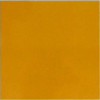
|

|
1946: Glossy Sea Blue (ANA 623/AMS-STD-595 15042) with Orange Yellow (ANA 614/AMS-STD-595 13538) wings and tail and Insignia Red (ANA 619/AMS-STD-595 31136) stripes & rudder.
| Scheme 2 - 1946 | Colors |
|---|---|

|

|

| |

|
1955: Engine Grey (ANA 513/AMS-STD-595 36007) with Orange Yellow (ANA 614/AMS-STD-595 13538) wings & Insignia Red (ANA 619/AMS-STD-595 31136) stripes & rudder.
| Scheme 3 - 1955 | Colors |
|---|---|

|

|

| |

|
1956: Landing gear bays are now white (ANA 601/AMS-STD-595 27875) instead of zinc chromate.
| Scheme 3 - 1956 | Colors |
|---|---|
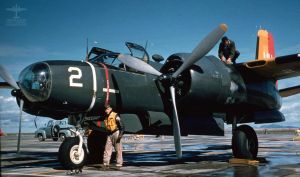
|

|

| |

|
1959: Engine Gray (ANA 513/AMS-STD-595 36007) with Orange Yellow (ANA 614/AMS-STD-595 13538) wing & Florescent Red (ANA 633/AMS-STD-595 28913) stripes & tail.
| Scheme 5 - 1959 | Colors |
|---|---|

|

|

| |

|
Variants
The US Navy operated several different Invader variants, based on the historical record.
- XJD-1 - There were two versions of this plane, an XJD-1B, and an XJD-1C. The B model was a hard nose model, ex-USAF 44-34217. It was given the Bureau Number 57990. It is believed that aside from having the armaments removed, this version was identical to the USAF version. The X model was ex-USAF 44-35467 and was a glass nosed model. It is also believed to have been identical in configuration to the USAF version.
- JD-1 - This was the Navy's primary version of the Invader. They all were stripped of all guns and were all glass-nosed C-models. Eventually the Navy custom built noses specific to this version.
- JD-1D - This version was a modified JD-1 that was outfitted and equipped to be a drone controller.
- JD-1X - An experimental version of the JD-1. At this time I do not know any particulars of this variant.
- JD-1DX - An experimental version of the JD-1D. At this time I do not know any particulars of this variant.
- UB-26J - The JD-1 as it was re-designated in 1962.
- DB-26J - The JD-1D as it was re-designated in 1962.
Ejection Seat Testing
In the fall of 1951 the US Navy modified BuNo 77216 to perform Ejection Seat Testing. The plane was assigned to the Parachute Experimental Unit at NAF El Centro, CA. These tests were conducted over El Centro, CA at a height of 1000' AGL with a 200 lb test dummy. The plane's bomb bay was modified to have an open fighter cockpit installed in the roof. This was the first US Military aircraft to test ejection seats, beating out the Air Force by several months. (The Air Force did not test ejection seats until 21 Mar 1962 in a B-58.) This fact makes this test noteworthy in military aviation history.
According to the records, the US Navy fielded a total of 152 JD-1s between 1945 and 1964. This data is compiled from the Naval Aircraft History Cards, the Aircraft Production Totals, and the Allowances and Location of Naval Aircraft reports.
The first two Invaders used by the Navy were both XJD-1s, used for evaluation of the Invader. From the records it appears that the two JD-1s were lent to the Navy for evaluation. The first one, 57990 - the hard nosed XJD-1, being delivered in March, 1945, and the second one, 57991 - the glass nosed XJD-1, being delivered in May, 1945 [2]. Both of these planes were originally assigned to VU-4 for evaluation [1]. They were both formally purchased by the Navy on 4 Jul 1945 with DoD contract number NAer-30000-192 [2].
On 11 Sep 1945 the Navy issued a second contract, NAer-40000-59, for 86 additional Invaders [2]. This block would be Bureau Numbers 77139 through 77224[2]. There is no mention on these reports about which USAF serial numbers the Navy planes originated as. One thing that can be gleaned is that either all of the USAF planes were sent to a processing facility for the Navy, or the Navy planes were delivered out of sequence numerically. The first 28 planes for this order were accepted by the Navy in Aug 1945, 7 more were accepted in Oct 1945, 10 more accepted in Nov 1945, and 5 more in Dec 1945[2]. That brings the total for the year to 50 planes of the 86 from contract number NAer-40000-59[2]. However, there is a remark in the 1945 report that says: "Ser. #77224 crashed enroute and will not be delivered."[2] Since this is the last plane in the block, and since the report is authored in 1945, the implication is that all of the USAF planes for this block were flown to some kind of Navy facility first, probably for processing and standardization. My guess would probably be the Overhaul & Repair Facility Norfolk, but this is only a guess.
The rest of the contract, NAer-40000-59 was delivered in 1946. [3]. 20 planes were accepted in Jan 1946, 11 in Feb 1946, 2 more in Mar 1946, and the final 2 in Apr 1946 [3]. The notes again refer to the fact that these are stripped down version of the Army Air Force models and were to be used primarily for Target Towing [3]. It also shows 1 Cancellation, and the footnote in the margin reiterates that 77224 crashed enroute and would not be delivered [3]. It is still unclear if exactly when and where it crashed, and who was piloting it. I have tried an initial search of US AAF accidents between July and Dec 1945 involving Invaders, but so far I have not found the plane. If the Navy personnel were flying the plane to an O&R facility then the accident may be listed under Naval records.
Additional information is pending the result of inquiry requests to the archives at this time. I will update this section as the information comes in.
This is a list of US Navy Tail Codes as it relates to the JD-1 Utility Squadrons.
| Squadron | Navy Tail Code | Date Assigned | Date Stopped | Comments |
|---|---|---|---|---|
| VU-1 | UA | 7 Nov 1946 | ||
| VU-2 | UB | 7 Nov 1946 | ||
| VU-2 | UJ | Jan 1952 | 1957 | Squadron Disestablished |
| VU-2 | JE | 1957 | Sep 1980 | Squadron Disestablished |
| VU-3 | UC | 7 Nov 1946 | ||
| VU-3 | UF | 1948 | ||
| VU-4 | UD | 7 Nov 1946 | ||
| VU-5 | UE | 7 Nov 1946 | ||
| VU-6 | UF | 7 Nov 1946 | 1948 | |
| VU-6 | UG | Mar 1952 | 1957 | |
| VU-6 | JG | 1957 | Aug 2008 | Squadron Disestablished |
| VU-7 | UH | 7 Nov 1946 | ||
| VU-8 | UI | 7 Nov 1946 | ||
| VU-9 | UK | 7 Nov 1946 | ||
| VU-10 | UL | 7 Nov 1946 | ||
| VU-10 | JH | 1957 | Aug 1993 | Squadron Disestablished |
| VX-2 | XB | 7 Nov 1956 | 1957 | |
| VX-2 | JB | 1957 |
- VU-1 - Utility Squadron 1
- VU-2 - Utility Squadron 2
- VU-3 - Utility Squadron 3
- VU-4 - Utility Squadron 4
- VU-5 - Utility Squadron 5
- VU-7 - Utility Squadron 7
- VU-9 - Utility Squadron 9
- VU-10 - Utility Squadron 10
- VX-1 - Air Test and Evaluation Squadron 1
- VX-2 - Operational Development Squadron 2
- NAMTC Point Mugu - Point Mugu
- VX-5 - China Lake
Bases, Pool, Storage, and Other Minor Assignments
- NAS Alameda
- Norfolk NAS
- Overhaul & Repair Facility Norfolk
- Overhaul & Repair Facility San Diego
- Naval Advance Base Oppama
- FASRON 110
- FASRON 116
- FASRON 117
- FASRON 118
- FASRON 199
- FASRON 691
- Litchfield Park Storage Facility
This page, linked below, is a table breaking down all of the JD-1s listed in the US Navy's "Allowances and Locations of Naval Aircraft" reports from Sep 1952 until the JD-1 was formally retired. It does not provide specific details on a Bureau Number level, but it does list unit strength and show the status of all planes assigned to a unit.
Reading the US Navy Inventory Cards can be tricky. I've put together a complete guide to help you decipher the cards.
Reading the Inventory Cards
The Navy Bureau Number list is complete. I can only cross-reference a handful of these planes to their original USAF serials. I am working on obtaining Inventory Cards from the US Naval Aviation Museum Library and cross-referencing those cards against USAF cards, but the process is slow and tedious and some of the records have been lost. If you have any additional information that can help fill in gaps, please let us know.
57XXX
These two planes were the original XJD-1 prototypes ordered by the Navy.
| Bureau Number | Date Accepted | Date Struck | Reason |
|---|---|---|---|
| 57990 | 16 Mar 1945 | 16 Nov 1962 | End of Service Life |
| 57991 | 21 May 1945 | 25 Feb 1960 | Damaged |
771XX
7713X
| Bureau Number | Date Accepted | Date Struck | Reason |
|---|---|---|---|
| 77139 | 3 Aug 1945 | 10 Oct 1963 | End of Service Life |
7714X
| Bureau Number | Date Accepted | Date Struck | Reason |
|---|---|---|---|
| 77140 | 3 Aug 1945 | 20 May 1960 | Administrative |
| 77141 | 4 Aug 1945 | 20 May 1960 | Administrative |
| 77142 | 8 Aug 1945 | 15 Jun 1964 | Administrative |
| 77143 | 19 Aug 1945 | 31 Jan 1947 | Accident |
| 77144 | 19 Aug 1945 | 20 May 1960 | Administrative |
| 77145 | 21 Aug 1945 | 31 Dec 1959 | Service Life Ended |
| 77146 | 21 Aug 1945 | Unknown | Partial Record |
| 77147 | 21 Aug 1945 | Unknown | Partial Record |
| 77148 | 22 Aug 1945 | 17 Jul 1961 | Service Life Ended |
| 77149 | 22 Aug 1945 | Unknown | Partial Record |
7715X
| Bureau Number | Date Accepted | Date Struck | Reason |
|---|---|---|---|
| 77150 | 23 Aug 1945 | 5 May 1960 | Administrative |
| 77151 | 23 Aug 1945 | 21 Sep 1959 | Administrative |
| 77152 | 23 Aug 1945 | Unknown | Partial Record |
| 77153 | 24 Aug 1945 | Unknown | Partial Record |
| 77154 | |||
| 77155 | |||
| 77156 | |||
| 77157 | |||
| 77158 | |||
| 77159 |
7716X
7717X
7718X
7719X
772XX
7720X
7721X
7722X
| Bureau Number | Date Accepted | Date Struck | Reason |
|---|---|---|---|
| 77220 | |||
| 77221 | |||
| 77222 | |||
| 77223 | |||
| 77224 | N/A | N/A | Not accepted, crashed enroute. |
80XXX
890XX
1403XX
14032X
14033X
14034X
14035X
14036X
14037X
- ↑ 1.0 1.1 "Aircraft History Cards". Naval Aviation Museum Library
- ↑ 2.0 2.1 2.2 2.3 2.4 2.5 2.6 2.7 "Aircraft Produced Under Navy Cognizance, 1945". Naval Aviation Museum Library
- ↑ 3.0 3.1 3.2 3.3 3.4 "Aircraft Produced Under Navy Cognizance, 1946". Naval Aviation Museum Library
- ↑ 4.0 4.1 Allowances and Location of Naval Aircraft, 1952. Naval History Museum Library.
